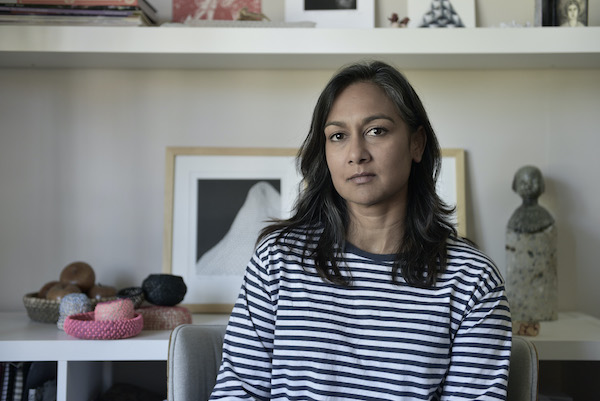For many years Perth-born artist Shanti Gelmi chose to deny the significance of her Indian heritage, a defensive response to the racism she encountered as a child. Recognising that her cultural heritage shaped her nonetheless, she now wonders what other unquestioned or unseen influences leave their stamp on us.
Out of the shadows
4 May 2021
- Reading time • 7 minutesVisual Art
More like this
- A walk with Tina Stefanou
- A blaze of glorious people
- Diving into the gothic world of Erin Coates
Shanti Gelmi’s work Absent Presence will appear in PICA’s “Hatched: 2021”, a survey of artworks by graduates of fine arts programs around Australia. She spoke to Nina Levy about her artistic path and the work she is presenting at “Hatched”.
Nina Levy: Tell me about your pathway to becoming an artist.
Shanti Gelmi: I grew up in a creative family. My mother is a seamstress, and my father is a musician. There were always new creative projects developing in our home from macrame to wedding dresses to home-made instruments, and there was always music.
These creative pursuits were hobbies though, and the “real jobs” were the ones that kept a roof over our heads and food on the table. With this firmly in mind, art remained a hobby for me too, even after commencing tertiary study in contemporary art. In 2019 I was awarded a scholarship to study art in Shanghai and this immersion was the catalyst for redefining my interest in art and prioritising it.

NL: During your formal training as an artist, what has influenced the kind of work you make?
SG: Somewhere at the mid-point of my study I was told it was not as important to be able to draw or paint realistically, as it was to get the concept of the artwork to the audience. This sparked an internal struggle which ultimately enabled me to let go of the idea that to be an artist I must master these mediums. My work is rooted in the idea I am interested in revealing and the medium and form is dictated by how it can be best understood.
NL: Your artist statement for “Hatched” talks about the issues you faced in your early life and the pressure to deny your cultural heritage to fit in – what form did those issues and pressures take?
SG: I am Australian born of migrant Indian parents and I became aware that I was different to the children in my neighbourhood when my sister and I were teased because of the colour of our skin. That first taunt of “blackie” when I was in primary school shocked me. I don’t think I had ever noticed skin colour before that, or how few coloured people there were in our immediate environments and how they gravitated toward each other. This was certainly true of my family’s social circle of Indian migrants – my weekends were filled religious celebrations and social interactions with fellow brown people, delicious food, singing, Indian folk songs, dancing and generally a lot of fun.
These interactions allowed my parents to feel belonging in Australia but they did the opposite for me. It wasn’t easy to change my name or skin colour, but in any way I could I behaved as the local children did – I cut my very long hair and begged my mum to purchase me clothes rather than make them.
I was frequently asked where I was from, which I found offensive so I would tell them the truth – “Forrestfield” – then when they persisted, “I was born in Midland and my parents got married here,” was my standard response, followed by a quick exit. I would never invite more questions, and felt I had to prove I belong here too.
NL: How is your work for “Hatched”, Absent Presence, shaped by those experiences?
SG: Absent Presence aims to draw attention to the influences and forces upon us that we may be unaware of or choose not to acknowledge. For me, this exploration began with the acknowledgement of the significance of my heritage. Although I denied it publicly for most of my life, its influence permeates my thoughts and actions, and has shaped the person I am. I began to wonder what other influences that I do not question, or feel powerless to change, shape me.

NL: Tell me about the processes you used to make Absent Presence.
SG: I used an ongoing series of drawings in which I explore connection, identity and behaviour using form and structure as a metaphor for interconnected existences, identity and behaviour as my starting point. Employing the same rules of process as the drawings, I cut and debossed industrial materials to create and enhance shadows, giving them agency in allowing absent influences a tangible presence. Poetically, the material is designed to absorb light, and deny shadows, making an important reference to the denial of cultural heritage.
NL: You’ve got various other exhibitions lined up this year – besides “Hatched” what is happening for you in 2021?
SG: I am grateful for a number of great collaborative experiences and group shows this year including “All That Remains”, a contemporary exhibition curated by Robyn Bernadt exploring memory, that opens in June at Ellenbrook Arts. Artists often form complex relationships with the notion of memory, using objects and images that represent the experience as visual language. It’s been a pleasure to develop work with this group of established and emerging artists, each with their own creative voice.
I am honoured to be selected for Future Proof Graduate Exhibition of Australian and New Zealand graduate printmakers through Megalo Print Studio which is currently online until 2 July 2021.
“Hatched: National Graduate Show” runs at PICA from 8 May – 11 July 2021.
Pictured top: Shanti Gelmi, ‘Absent Presence’, 2020, Photo: Eva Fernandez
Like what you're reading? Support Seesaw.






